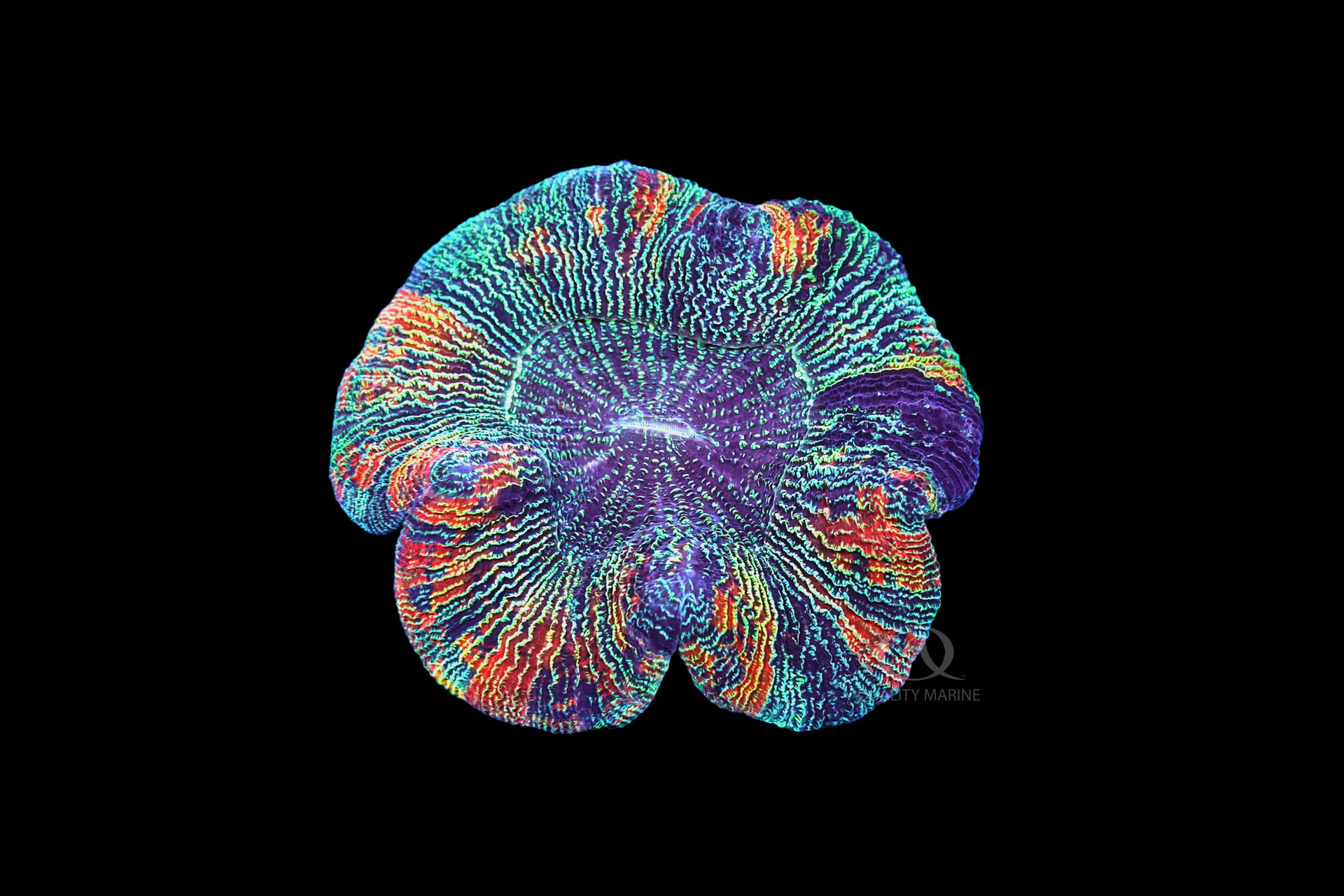The King In The Corner

Trachyphyllia geoffroyi is the coral most of us call the “Open Brain Coral,” or just “Trachy.” A few years back, we thought Open Brain Corals were actually two species, the other being Wellsophyllia radiata. While some sources still differentiate these corals, officially they have been grouped with Trachyphyllia geoffroyi; their very slight physical differences are seen as variance within a species.
Trachys are a Long Polyp Stony coral, as they have a rocklike base and and large fleshy polyp / mantle that grows out of it. They start life attached to rocks on reefs and over time will detach and become free living corals. In the cases of successful settlement, the stony base helps the coral stay fleshy side up in sandy or muddy environments where their delicate fleshy mantle is protected from harsh flow and sharp rocky edges. They are usually found in relatively shallow water, in more peaceful and protected conditions.
There is a sliding scale as to which of these wild conditions is most important to mimic for the long term health of your Brain, and without question, the number one most important aspect of keeping Trachys happy is gentle, non-laminar flow. They require some flow to keep them clean, but powerheads and other flow generating devices should NEVER ever be pointed at any fleshy polyped coral, and Open Brain Corals are especially vulnerable to flow as a threat.
The next important element of successful husbandry is light. It has been our experience over the decades that while Open Brain Corals can be acclimated to higher light locations, they do best in low to moderate light. This is the perfect coral for low in your aquarium, and even better in a corner where light (and flow) are the most diffuse and gentlest.
While in the wild the Trachyphyllia geoffroyi is found in sand and mud, it doesn't necessarily need to be on sand or mud. We have seen them kept successfully in barebottom tanks for years at a time, but some care should be taken to brace the coral so that it doesn't rock back and forth on its tapered stony base. We have seen people use aquarium safe rock epoxy to make a flat base, and others have used pvc rounds cut low which can also work. They should not be placed on rockwork, unless it is very smooth and rounded. The singular polyp or mantle of this coral is very delicate, and the happier it gets, the more this polyp grows and extends. It is easy to damage and this is frequently the cause of failure for hobbyists. If you've ever heard the phrase, “it was fine up on that rock, it was super happy, then all of a sudden it wasn't” That is frequently polyp damage. There are lots of corals to go up on your rocks, and not as many that look beautiful on the bottom of your tank. Embrace this coral for what it is and place it on the bottom. It will thank you, and you will thank us.
Last, but certainly not least important is food. Like most large polyp corals, Trachyphyllia geoffroyi loves a good meaty meal, and will take surprisingly big ones. Usually starting in the evening and often going till morning, your Open Brain coral will extend feeder tentacles from the fringe around its oral disc (fancy way of saying mouth) and these can be target fed meaty meals, and surprisingly large ones. We will feed these guys krill or other thawed marine based meaty foods that are similarly sized on a weekly or slightly more often basis. As the coral gets bigger, it will need more food. You can judge if you're over feeding by watching it for excess waste. If the coral is expelling undigested meat, you're over feeding it. Filter feeding Trachyphyllia very fine foods is often recommended, though we've found they do better with slightly bigger meals, slightly less frequently. If you have an aquarium with a lot of cleaner shrimp, it will be difficult to get them to stop stealing from your Open Brain Coral. Physical barriers, like an upside down mesh basket, can help give your coral enough time to get the food down without getting robbed. Fish are generally less of a problem unless they are decidedly nocturnal.
As one last aside, over the years, we've seen lots of clownfish adopt Trachyphyllia as their “anemone,” often times even when they had a healthy, appropriate anemone to utilize as a host. When the Trachy is huge, and the clownfish are small this arrangement can work well for the coral. The fish will help bring it food and help remove waste, they will run off cleaner shrimp and other would be thieves. However, if the clowns are too big, or the coral too small, there is a risk that they will “love it to death” meaning all their swimming around in it and yard work will irritate the coral to the point of physical deterioration and damage. As a result, be wary of housing large clownfish like Maroons or Tomato clowns in aquariums with Trachys.
Trachyphyllia geoffroyii is one of the aquarium hobby's most beautiful and least demanding corals. While there are a few things that would spell certain doom for this coral, avoiding these pitfalls is pretty straightforward. Their lack of demand for flow and light makes them well suited for the aquariums of less experienced reef keepers while their stunning coloration and movement makes them an ideal piece to add visual interest to previously unused areas of mixed reef environments. As long as you have suitable tankmates, stable, low nutrient water quality and a good spot to put one, an Open Brain Coral from Quality Marine should be on your list. Ask your LFS about getting one from us today!